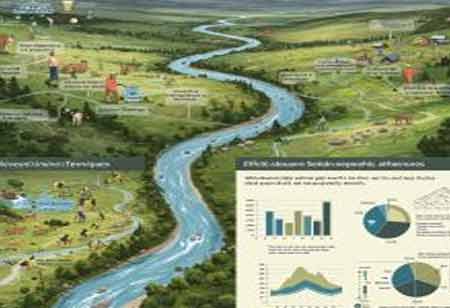Thank you for Subscribing to Environmental Business Review Weekly Brief
Technology-Driven Approaches in Watershed Management
Watershed management is increasingly recognized as a critical strategy for maintaining and enhancing water quality, biodiversity, and overall ecosystem health.

By
Environmental Business Review | Friday, April 04, 2025
Stay ahead of the industry with exclusive feature stories on the top companies, expert insights and the latest news delivered straight to your inbox. Subscribe today.
Advancements in watershed management are enhancing water resource sustainability, resilience, and collaboration for future generations.
Fremont, CA: Watershed management is increasingly recognized as a critical strategy for maintaining and enhancing water quality, biodiversity, and overall ecosystem health. As climate change and urban expansion pose new challenges, innovative approaches are emerging to address these issues effectively.
Technological Innovations in Monitoring and Management
Technology has revolutionized watershed management, providing tools for more precise monitoring and planning. Geographic Information Systems (GIS) and remote sensing have become essential for mapping watersheds, identifying pollution sources, and analyzing land use changes. These technologies help watershed managers visualize complex data and make informed decisions. Moreover, integrating Internet of Things (IoT) devices has enabled real-time water quality monitoring.
Sensors can detect pollutants and measure temperature, pH, and turbidity, allowing immediate responses to environmental changes. Drones with high-resolution cameras and sensors are also used to survey large areas, providing previously challenging data. Machine learning algorithms are crucial in predicting hydrological responses to land use changes and climate variability. These algorithms can forecast potential flooding events or drought conditions by analyzing historical data, allowing for proactive management strategies. Combining these technologies leads to more sustainable and adaptive watershed management practices.
Collaborative Governance Models
Advancements in watershed management have also been facilitated through collaborative governance models that engage multiple stakeholders, including government agencies, non-profit organizations, local communities, and private sectors. These collaborative efforts are essential for addressing complex watershed issues that cross political and administrative boundaries. One effective model is the establishment of watershed alliances or partnerships, which bring together diverse interests to develop comprehensive management plans.
These alliances often prioritize stakeholder input and integrate local knowledge, leading to more effective and accepted management practices. Furthermore, public participation is increasingly being incorporated into decision-making processes. Community workshops, surveys, and online platforms allow for greater engagement and transparencies, ensuring all voices are heard. This collaborative approach fosters a sense of ownership among community members and enhances the resilience of watershed ecosystems by aligning management practices with local values and needs.
Ecosystem Restoration and Conservation
Ecosystem restoration has emerged as a vital component of modern watershed management. Many initiatives now focus on restoring degraded wetlands, riparian zones, and forests, recognizing the connection between land and water systems to enhance water quality and provide habitat for wildlife. These restoration efforts are supported by scientific research demonstrating healthy ecosystems' ecological and economic benefits. Nature-based solutions, such as the construction of green infrastructure, are becoming more popular in urban areas.
Techniques like permeable pavements, rain gardens, and bioswales help manage stormwater runoff, reducing pollution and flooding risks while improving urban aesthetics. Moreover, funding for watershed restoration projects is increasingly available through government programs and grants, encouraging more communities to invest in sustainable practices. In addition, partnerships with local organizations and agencies can amplify impact, ensuring that restoration efforts are holistic and adaptive to changing conditions.





